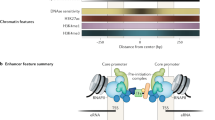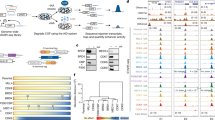Abstract
RETINOIC acid receptors (RARs) and retinoid-X receptors (RXRs) activate or repress transcription by binding as heterodimers to DNA-response elements that generally consist of two direct repeat half-sites of consensus sequence AGGTCA (reviewed in ref. 1). On response elements consisting of direct repeats spaced by five base pairs (DR + 5 elements), RAR/RXR heterodimers activate transcription in response to RAR-specific ligands, such as all-trans-retinoic acid (RA)2. In contrast, on elements consisting of direct repeats spaced by one base pair (DR + 1 elements), RAR/RXR heterodimers exhibit little or no response to activating ligands and repress RXR-dependent transcription3. Here we show that ligand-dependent transactivation by RAR on DR + 5 elements requires the dissociation of a new nuclear receptor co-repressor, N-CoR, and recruitment of the putative co-activators p140 and p160 (refs 4, 5). Surprisingly, on DR + 1 elements, N-CoR remains associated with RAR/RXR heterodimers even in the presence of RAR ligands, resulting in constitutive repression. These observations indicate that DNA-response elements can allosterically regulate RAR-co-repressor interactions to determine positive or negative regulation of gene expression.
This is a preview of subscription content, access via your institution
Access options
Subscribe to this journal
Receive 51 print issues and online access
$199.00 per year
only $3.90 per issue
Buy this article
- Purchase on Springer Link
- Instant access to full article PDF
Prices may be subject to local taxes which are calculated during checkout
Similar content being viewed by others
References
Glass, C. K. Endocr. Rev. 15, 1503–1519 (1994).
Umesono, K., Murakami, K. K., Thompson, C. C. & Evans, R. M. Cell 65, 1255–1266 (1991).
Mangelsdorf, D. J. et al. Cell 66, 555–561 (1991).
Halachmi, S. et al. Science 264, 1455–1458 (1994).
Cavailles, V., Dauvois, S., Danielian, P. S. & Parker, M. G. Proc. natn. Acad. Sci. U.S.A. 91, 10009–10013 (1994).
Kurokawa, R. et al. Nature 371, 528–531 (1994).
Kurokawa, R. et al. Genes Dev. 7, 1423–1435 (1993).
Perlmann, T., Rangarajan, P. N., Umesono, K. & Evans, R. M. Genes Dev. 7, 1411–1422 (1993).
Zechel, C. et al. EMBO J. 13, 1425–1433 (1994).
Foreman, B. M., Umesono, K., Chen, J. & Evans, R. M. Cell 81, 541–550 (1995).
Le Douarin, B. et al. EMBO J. 14, 2020–2033 (1995).
Lee, J. W. et al. Nature 374, 91–94 (1995).
Danielian, P. S., White, R., Lees, J. A. & Parker, M. G. EMBO J. 11, 1025–1033 (1992).
Durand, B. et al. EMBO J. 13, 5370–5382 (1994).
Barettino, D., Vivanco Ruiz, M. M. & Stunnenberg, H. G. EMBO J. 13, 3039–3049 (1994).
Tone, Y., Collingwood, T. N., Adams, M. & Chatterjee, V. K. J. biol Chem. 269, 31157–31161 (1994).
Baniahmad, A. et al. Molec. cell. Biol. 15, 76–86 (1995).
Casanova, J. et al. Molec. cell Biol. 14, 5756–5765 (1995).
Hörlein, A. et al. Nature 377, 397–404 (1995).
Keidel, S., LeMotte, P. & Apfel, C. Molec. cell. Biol. 14, 287–298 (1994).
Kaelin, W. G. Jr. et al. Cell 70, 351–364 (1992).
Author information
Authors and Affiliations
Rights and permissions
About this article
Cite this article
Kurokawa, R., Söderström, M., Hörlein, A. et al. Polarity-specific activities of retinoic acid receptors determined by a co-repressor. Nature 377, 451–454 (1995). https://doi.org/10.1038/377451a0
Received:
Accepted:
Issue Date:
DOI: https://doi.org/10.1038/377451a0
This article is cited by
-
Regulatory changes associated with the head to trunk developmental transition
BMC Biology (2023)
-
Genetics and functions of the retinoic acid pathway, with special emphasis on the eye
Human Genomics (2019)
-
Diverse feather shape evolution enabled by coupling anisotropic signalling modules with self-organizing branching programme
Nature Communications (2017)
-
Mechanisms of retinoic acid signalling and its roles in organ and limb development
Nature Reviews Molecular Cell Biology (2015)
-
Structural Basis of Natural Promoter Recognition by the Retinoid X Nuclear Receptor
Scientific Reports (2015)
Comments
By submitting a comment you agree to abide by our Terms and Community Guidelines. If you find something abusive or that does not comply with our terms or guidelines please flag it as inappropriate.



